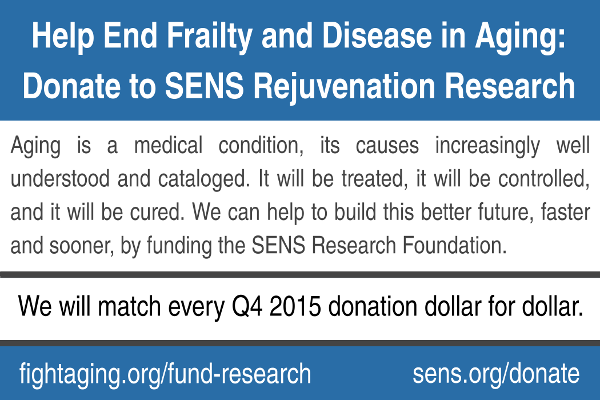A Brief Look at Retrotope
Today, I'll point out the early stage company Retrotope, more out of curiosity than as an example of a research and development strategy that I'd favor pursuing. They don't make it terribly easy to see exactly what they're up to, as seems to be the trend for the online presence of young biotech companies these days, but the digest is that the staff there are trying to build therapies based on substituting deuterium for hydrogen in some of the molecules employed in cellular structure and machinery.
As long-time readers will no doubt recall, a slow trickle of evidence has arrived over the past decade to suggest that replacing a small fraction of hydrogen atoms with deuterium atoms in the proteins and other molecular machinery of a living organism produces a slight beneficial outcome to health and longevity. Deuterium is an isotope of hydrogen, with a nucleus containing a proton and a neutron rather than just a proton. So it is twice as heavy, but with the same single electron as hydrogen it has similar chemical properties. Molecules in which this substitution has been made have broadly similar characteristics, but there is enough of a difference to ensure that, for example, heavy water is toxic, more so to lower animals than to mammals, and, apparently, that a low level of deuterium substitution in cellular machinery can be slightly beneficial. In studies of deuterium substitution a common methodology is to culture worms, flies, and so forth, with a diluted dose of heavy water and then observe the results. You'll find examples back in the Fight Aging! archives.
This exploration has to date been anemic and far from conclusive, for all that it is a fascinating topic, and this is why I point out Retrotope. I imagine that the efforts to run a potential isotope substitution treatment through a clinical trial, currently in the recruitment phase, may prove to be the sharp edge of work that advances the state of knowledge regarding the effects of isotope substitution on cellular biology. It is undeniably interesting stuff from a life science perspective, regardless of its likely poor best possible outcome in comparison to damage repair approaches to treating aging. Even the current trial is for the inherited condition Friedreich's ataxia, with only vaguely similar mechanisms to aging involved in its pathology.
In any case, the basic plot here is based on the view that the presence of heavier isotopes helps to resist the effects of oxidative stress, the damage to molecular machinery caused by the presence of free radicals, whether produced by disease processes, aging processes, or less common issues such as radiation exposure. Somewhere between an absence of deuterium and enough deuterium to be toxic lies a level at which enough of a benefit is produced to be worth turning it into a treatment. This, at least, is the hope. Various other strategies aimed at ameliorating oxidative stress should give us some idea as to the plausible range of expected outcomes for this sort of approach. For example, you might look at the results from gene therapies to boost levels of the antioxidant catalase in cells. These are not large positive effects in the grand scheme of things, I'm sorry to say.
Pill of superprotective 'heavy' fat
Mikhail Shchepinov, director of Retrotope, a biotech company based in Los Altos, California, wants eventually to slow down the ageing process. But he is starting with a related problem - treating the inherited movement disorder Friedreich's ataxia, with which ageing shares a mechanism. They are both caused, in part, by a molecular attack on our cells. Shchepinov's idea is to counteract this assault by reinforcing our cells' defences, slowing the progression of this incurable disease. If it works, it should demonstrate that the approach is also suitable for tackling ageing.He reckons we can protect our cells from free radicals simply by strengthening the bonds between molecules that make up our cell membranes. This can be done by swapping the hydrogen in the fatty acids for a different form known as deuterium. Because deuterium has an extra neutron, it is heavier than hydrogen and forms stronger bonds.
Targeting lipid peroxidation and mitochondrial imbalance in Friedreich's ataxia
Oxidative stress can be the cause and/or the consequence of mitochondrial energy imbalance, leading to cell death. Fibroblasts from two mouse models were used to analyse two different categories of protective compounds: deuterised poly-unsaturated fatty acids (dPUFAs) and Nrf2-inducers. The former have been shown to protect the cell from damage induced by lipid peroxidation and the latter trigger the well-known Nrf2 antioxidant pathway. Our results show that the sensitivity to oxidative stress of mouse fibroblasts, resulting in cell death and lipid peroxidation, can be prevented by d4-PUFA and Nrf2-inducers.
Retrotope is currently assessing technical proof of principle, regulatory requirements, and viability of several products in multiple market segments. The company has a pipeline of products, including single agent and multiple stabilized polyunsaturated fatty acids (PUFAs), stabilized amino acids, each in a variety of indications. Pharmaceutical candidates include:1) Fortified lysine: Anti-metastatic agent against cancer proliferation and fibrotic disease, downregulating the effects of LOX, a well documented target for pathological collagen crosslinking.
2) Stabilized fatty acids: Treatment and high risk mitigation of diseases involving oxidative mitochondrial membrane damage. Anti-proliferative for protein damage and aggregation in Parkinson's and other orphan central nervous system diseases, using stabilized fatty acid mimetics.3) Episodic or regular intervention for radiation exposure events or at high radiation- risk populations (e.g. security personnel, military, etc).

